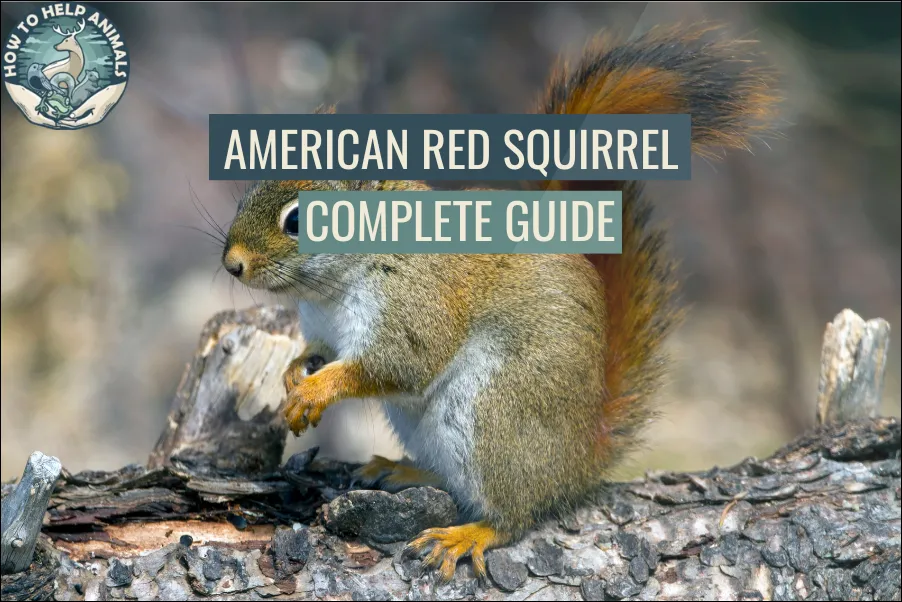
The crisp mountain air carries the distinctive chattering of an unseen critic high in the pine canopy. Suddenly, a small, rust-colored blur spirals down the trunk with remarkable agility, pausing just long enough to fix you with bright, intelligent eyes before delivering a scolding series of rapid-fire calls. This feisty little character is the American Red Squirrel – pound for pound, perhaps North America’s most spirited and vocal tree squirrel.
The American Red Squirrel (Tamiasciurus hudsonicus) is North America’s smallest tree squirrel, distinguished by its fiery temperament, distinctive reddish coat, and remarkable adaptation to coniferous forests. Unlike the larger Eastern Gray Squirrel, Western Gray Squirrel, or Fox Squirrel, Red Squirrels are highly territorial specialists that have mastered life in the challenging northern forests and mountain regions across much of Canada and the northern United States.
| Attribute | Details |
|---|---|
| Scientific Name | Tamiasciurus hudsonicus |
| Size | 11-14 inches total length |
| Weight | 140-250 grams (0.3-0.6 lbs) |
| Lifespan | 4-8 years wild, up to 10 years maximum |
| Habitat | Coniferous and mixed forests, mountainous regions |
| Diet | Specialist: pine seeds, spruce cones, fungi, tree sap |
| Activity | Diurnal (most active dawn and dusk) |
| Conservation Status | Least Concern (stable populations) |
Physical Description & Identification
Size and Build Comparison
American Red Squirrels stand out immediately due to their compact size, measuring significantly smaller than their cousins. While Fox Squirrels can weigh up to 1000 grams and Eastern Gray Squirrels typically reach 400-600 grams, Red Squirrels rarely exceed 250 grams, making them true miniatures of the tree squirrel world.
This diminutive stature serves them well in their coniferous forest habitats, where agility and energy efficiency matter more than raw strength. Their lightweight build allows them to access the outermost branches of conifers where the choicest cones hang, territories that would be impossible for the bulkier Fox Squirrel or Western Gray Squirrel to safely navigate.
Adult American Red Squirrels typically measure 11-14 inches from nose to tail tip, with their bushy tails accounting for roughly 40% of their total length. Their compact, muscular bodies reflect adaptations for rapid climbing and the constant activity required to maintain their demanding territorial lifestyle.

Distinctive Coat Coloration and Seasonal Changes
Summer Coat (April-September): The classic American Red Squirrel sports a rich reddish-brown to rusty-orange dorsal coloration that provides their common name. This vibrant coloration varies considerably across their range, from bright rust-red in eastern populations to more subdued brownish-red in western mountain regions.
The underside displays a striking white to cream-colored belly that extends from chin to tail, creating a sharp demarcation line along the flanks. This distinctive color pattern helps distinguish Red Squirrels from any other North American tree squirrel species.
Winter Coat (October-March): Winter pelage grows considerably denser and often displays more muted tones, with the reddish coloration becoming more brownish and less vibrant. Most notably, many individuals develop prominent ear tufts during winter months – distinctive black-tipped tufts that give them an almost lynx-like appearance.
Regional Color Variations: Across their extensive range, American Red Squirrels show interesting regional color variations:
- Eastern populations: Brighter, more vibrant red-orange coloration
- Western mountain populations: More subdued brown-red with grayer tones
- Northern populations: Often display more pronounced winter ear tufts
- Humid coastal regions: Slightly darker, more saturated coloration

Distinguishing Features and Identification
Tail Characteristics:
- Proportionally smaller than other tree squirrel species
- Dense, bushy appearance with reddish-brown coloration
- Often held in distinctive curved position over back
- Black-tipped guard hairs creating frosted appearance
- Used extensively for balance during rapid arboreal movements
Facial and Head Features:
- Large, prominent dark eyes adapted for forest environments
- Distinctive white eye-ring becoming more prominent in winter
- Small, rounded ears that develop dramatic tufts in cold climates
- Proportionally larger head compared to body size than other squirrel species
- Sharp, prominent teeth adapted for cone processing
Body Structure Adaptations:
- Compact, muscular build optimized for energy efficiency
- Sharp, curved claws providing exceptional grip on bark
- Powerful hindquarters enabling impressive leaping ability
- Flexible spine allowing rapid directional changes while climbing
- Specialized jaw muscles for processing tough conifer seeds
Behavioral Identification Markers:
- Extremely vocal with diverse repertoire of calls and chatter
- Highly territorial and aggressive toward intruders
- Rapid, jerky movements contrasting with deliberate movements of larger squirrel species
- Frequent cone-cutting behavior leaving distinctive debris piles
- Bold, curious nature often approaching humans more closely than other squirrel species
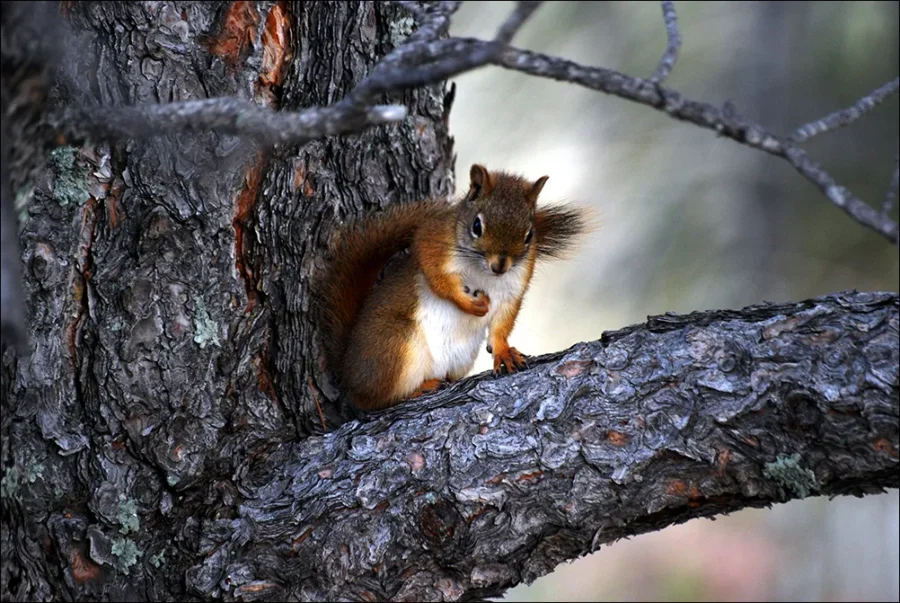
Habitat & Distribution
Continental Range and Biogeographic Patterns
American Red Squirrels occupy one of the most extensive ranges of any North American mammal, spanning the entire boreal forest region from Alaska to Newfoundland and extending south through mountainous regions to Arizona and New Mexico. This remarkable distribution reflects their specialization for coniferous forest ecosystems that dominate northern and montane regions.
Unlike the more temperate preferences of Eastern Gray Squirrels or the oak woodland requirements of Western Gray Squirrels, Red Squirrels have evolved as true boreal specialists, thriving in environments that challenge most other tree squirrel species. Their range closely follows the distribution of spruce, fir, and pine forests across the continent.
Geographic Distribution:
- Northern boundary: Arctic treeline across Alaska and northern Canada
- Southern boundary: High elevation forests in southwestern United States
- Eastern extent: Atlantic provinces and northeastern United States
- Western extent: Pacific Coast ranges and Rocky Mountain system
- Elevation range: Sea level to over 10,000 feet in mountain regions
Coniferous Forest Specialization
Primary Habitat Requirements: American Red Squirrels demonstrate strong preferences for mature coniferous forests dominated by cone-producing trees. Their habitat selection differs markedly from the more generalized habitat use of Fox Squirrels or the deciduous forest preferences typical of Eastern Gray Squirrels.
Optimal Forest Characteristics:
- Canopy dominance by spruce, fir, pine, or hemlock species
- Mature trees producing abundant cone crops
- Dense canopy providing protection from aerial predators
- Minimal understory allowing easy ground movement
- Adequate water sources within territorial boundaries
- Natural cavities or dense branching for nest construction
Conifer Species Associations:
- White spruce (Picea glauca): Primary habitat across boreal regions
- Black spruce (Picea mariana): Important in northern and wetland areas
- Balsam fir (Abies balsamea): Key species in eastern boreal forests
- Douglas fir (Pseudotsuga menziesii): Critical in western mountain regions
- Lodgepole pine (Pinus contorta): Important in Rocky Mountain ecosystems
- Red pine (Pinus resinosa): Significant in Great Lakes region
Elevational and Climatic Adaptations
Mountain Ecosystem Adaptations: In western North America, Red Squirrels occupy montane and subalpine forest zones, demonstrating remarkable adaptability to high-elevation conditions that would challenge larger squirrel species like Fox Squirrels.
High-Elevation Specializations:
- Cold tolerance through dense winter pelage and behavioral adaptations
- Enhanced oxygen extraction efficiency for high-altitude environments
- Seasonal migration patterns following cone production cycles
- Modified activity patterns adjusted to shorter growing seasons
- Enhanced food storage capabilities for extended winter periods
Boreal Forest Adaptations: Throughout their northern range, Red Squirrels have evolved numerous adaptations for surviving long, harsh winters and exploiting the seasonal abundance of northern forests.
Cold Climate Specializations:
- Exceptional cold tolerance allowing activity in sub-zero temperatures
- Efficient thermoregulation through behavioral and physiological adaptations
- Enhanced spatial memory for relocating cached food sources
- Modified reproductive timing to optimize offspring survival
- Specialized dietary flexibility for surviving resource scarcity periods

Habitat Micromanagement and Territory Structure
Territory Organization: Red Squirrels maintain smaller but more intensively defended territories compared to the extensive ranges typical of Fox Squirrels. Their territorial system reflects the patchy distribution of high-quality cone resources in coniferous forests.
Territory Components:
- Core area: 0.2-2.0 acres containing primary nest sites and major food caches
- Foraging range: Extended area for seasonal resource exploitation
- Cache sites: Strategic locations for long-term food storage (middens)
- Nest trees: Multiple cavity sites for different seasonal requirements
- Territorial boundaries: Actively defended borders marked through scent and vocalizations
Midden Systems: Perhaps the most distinctive feature of Red Squirrel ecology involves their creation and maintenance of middens – large piles of cone scales and debris that serve as both food storage sites and territorial markers.
Midden Characteristics:
- Size: Can exceed 30 feet in diameter and several feet in height
- Composition: Primarily cone scales, but also includes cached whole cones
- Location: Strategic placement near nest sites and water sources
- Inheritance: Territories and middens passed between generations
- Multi-year development: Some middens accumulate debris for decades

Diet & Feeding Behavior
Conifer Seed Specialization
American Red Squirrels have evolved as true conifer seed specialists, displaying feeding behaviors and adaptations that distinguish them dramatically from the more generalized diets of Eastern Gray Squirrels, Western Gray Squirrels, and Fox Squirrels. Their entire ecosystem revolves around the boom-and-bust cycles of conifer cone production.
Seasonal Dietary Patterns:
Spring Diet (March-May):
- Fresh conifer needles and shoots providing essential vitamins
- Tree sap accessed through specialized bark gnawing techniques
- Cached conifer seeds from previous autumn harvest
- Early fungi and mushrooms emerging from forest floor
- Bird eggs and nestlings during peak breeding periods
- Flower buds from deciduous trees when available
Summer Diet (June-August):
- Developing conifer cones harvested before full maturation
- Fungi and mushrooms, particularly boletes and chanterelles
- Fresh vegetation including leaves and herbaceous plants
- Insects and larvae providing essential protein sources
- Berries and fruits from understory shrubs
- Fresh tree sap during active growth periods
Autumn Diet (September-November):
- Primary focus: Intensive conifer cone harvesting and processing
- Mature cones from spruce, fir, pine, and hemlock
- Nuts from deciduous trees when available (supplemental)
- Late-season fungi and mushroom species
- Increased caloric intake preparing for winter survival
- Peak caching activity with systematic cone storage
Winter Diet (December-February):
- Heavy reliance: Cached conifer seeds from midden stores
- Inner bark (cambium) during severe food shortages
- Remaining stored cones and processed seeds
- Limited fresh vegetation during dormant period
- Opportunistic feeding on available winter-persistent fungi
- Snow foraging for partially buried food items
Cone Processing and Harvesting Techniques
Red Squirrels have developed sophisticated techniques for harvesting and processing conifer cones that represent some of the most specialized feeding behaviors among North American mammals.
Cone Harvesting Strategies:
- Timing optimization: Cutting cones just before peak ripeness to prevent seed dispersal
- Systematic cutting: Working methodically through individual trees
- Green cone preference: Harvesting before cones open and release seeds
- Rapid processing: Cutting and dropping cones faster than gravity allows natural fall
- Strategic storage: Immediate transport to midden sites for processing
Processing Techniques:
- Scale removal: Systematic stripping of cone scales to access seeds
- Seed extraction: Precise manipulation to remove individual seeds
- Quality assessment: Ability to detect and discard damaged or empty seeds
- Waste management: Organized disposal of scales creating distinctive midden piles
- Efficiency optimization: Processing techniques that maximize energy return
Midden Management and Food Storage
The midden system represents one of the most sophisticated food storage strategies found among North American wildlife, surpassing even the impressive caching behaviors observed in Fox Squirrels.
Midden Construction and Maintenance:
- Site selection: Strategic placement considering drainage, protection, and access
- Foundation development: Creating stable bases for long-term accumulation
- Layered storage: Organized placement of different cone types and processing debris
- Moisture management: Maintaining optimal humidity for seed preservation
- Pest control: Behavioral strategies reducing insect and fungal damage
Cache Organization Systems:
- Central storage: Primary middens containing majority of winter food supply
- Satellite caches: Smaller storage sites throughout territory for emergency access
- Seasonal rotation: Systematic use of different cache sites based on accessibility
- Quality maintenance: Regular inspection and reorganization of stored materials
- Theft prevention: Vigilant defense against cache raiding by competitors
Storage Efficiency and Longevity:
- Preservation techniques: Methods maintaining seed viability for multiple years
- Inventory management: Apparent awareness of cache contents and locations
- Consumption patterns: Strategic use of stored resources throughout winter
- Surplus management: Accumulation of multi-year food supplies during abundant seasons
- Risk distribution: Multiple cache sites reducing catastrophic loss potential
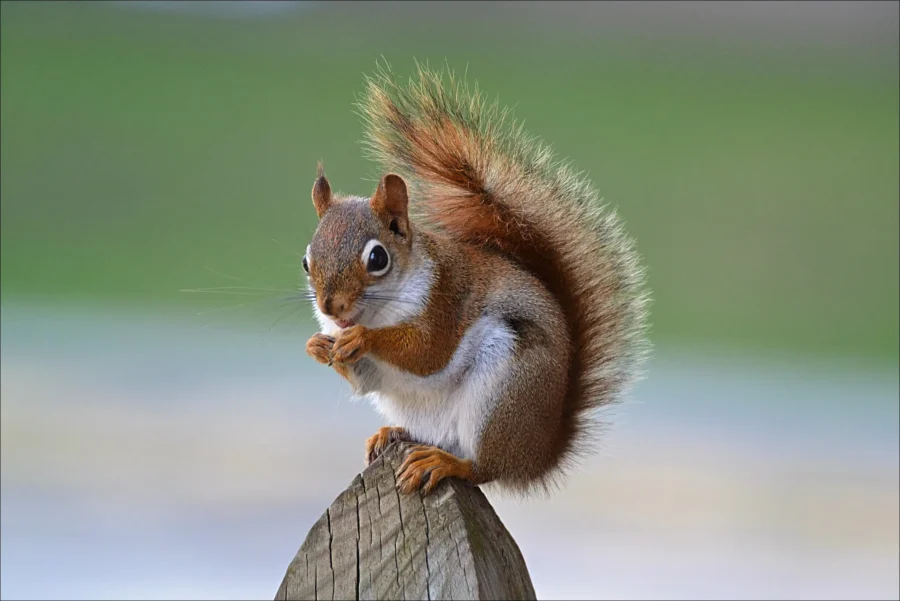
Foraging Behavior and Territory Defense
Daily Foraging Patterns: Red Squirrels maintain highly structured daily routines centered around territory patrol, cache maintenance, and active foraging, displaying more rigid behavioral patterns than the more flexible schedules typical of Eastern Gray Squirrels.
Foraging Efficiency Adaptations:
- Route optimization: Systematic patrol patterns maximizing territory coverage
- Energy conservation: Minimizing travel distances between productive areas
- Threat assessment: Constant vigilance for territorial intruders and predators
- Resource evaluation: Rapid assessment of food quality and quantity
- Competitive exclusion: Aggressive defense of high-quality foraging areas
Territorial Foraging Defense:
- Vocal intimidation: Loud calling to discourage territorial intrusion
- Physical confrontation: Direct aggressive interactions with intruding squirrels
- Scent marking: Chemical marking of territorial boundaries and resources
- Visual displays: Body posturing and tail flagging during territorial disputes
- Persistent harassment: Continued aggressive behavior driving away competitors
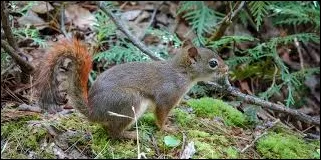
Reproduction & Life Cycle
Breeding Season and Reproductive Timing
American Red Squirrels typically experience a single annual breeding season, though timing varies significantly based on latitude, elevation, and local environmental conditions. Their reproductive strategy differs from the more flexible breeding patterns observed in Fox Squirrels and Eastern Gray Squirrels.
Primary Breeding Season (February-May): Red Squirrel breeding typically occurs during late winter and early spring, with timing adjusted to ensure offspring are born when environmental conditions optimize survival prospects and food resources become increasingly available.
Geographic and Elevational Variations:
- Northern populations: Later breeding (April-May) due to extended winter conditions
- Southern populations: Earlier breeding (February-March) in milder climates
- High elevation: Delayed breeding based on snowpack and temperature patterns
- Coastal regions: Modified timing based on maritime climate influences
Environmental Breeding Triggers:
- Photoperiod changes: Increasing daylight stimulating reproductive hormones
- Temperature patterns: Sustained warming trends indicating seasonal progression
- Food availability: Cone crop abundance influencing reproductive success rates
- Territory quality: Resource availability affecting breeding participation
- Population density: Local competition levels influencing reproductive timing
Courtship Behaviors and Mating Systems
Red Squirrel courtship involves intense vocalizations and aggressive competitive interactions that reflect their highly territorial nature and small body size requiring efficient energy use.
Pre-Mating Behaviors:
- Territorial calling: Extended vocal displays advertising reproductive status
- Scent marking intensification: Enhanced chemical communication throughout territories
- Male territory expansion: Temporary enlargement of territories to access females
- Competitive interactions: Intense male-male competition for mating opportunities
- Courtship chasing: High-speed pursuit sequences through forest canopy
Mating Process: Female Red Squirrels typically mate with multiple males during their brief receptive period, which lasts 6-8 hours. This polyandrous system ensures genetic diversity while allowing females to assess male quality through behavioral displays and competitive success.
Courtship Communication:
- Vocal repertoires: Complex vocalizations including chatter, trills, and contact calls
- Visual signaling: Tail positioning and body postures communicating reproductive intent
- Scent communication: Specialized gland secretions and urine marking
- Physical interactions: Grooming behaviors and gentle aggressive interactions
- Territory tours: Males guiding females through territory quality demonstrations
Nest Site Selection and Construction
Gestation Period: 31-35 days
Nest Site Preferences: Red Squirrels demonstrate remarkable flexibility in nest site selection, utilizing both natural cavities and constructed dreys based on local availability and seasonal requirements.
Natural Cavity Utilization:
- Tree cavities: Hollow sections in mature conifers and occasional deciduous trees
- Woodpecker holes: Abandoned cavities enlarged through gnawing and modification
- Rock crevices: Natural formations in rocky terrain providing protection
- Root systems: Underground cavities among large tree root networks
- Cliff sites: Protected locations in rocky outcrops and steep terrain
Drey Construction Techniques:
- Framework development: Outer structure built from twigs and small branches
- Insulation layers: Inner lining created from moss, lichen, and soft plant materials
- Weather protection: Strategic placement and construction for wind and precipitation protection
- Multiple entrances: Emergency escape routes essential for predator avoidance
- Seasonal modifications: Ongoing maintenance and improvement throughout occupancy
Urban and Disturbed Habitat Adaptations:
- Building cavities: Utilization of human structures including attics and sheds
- Artificial structures: Adaptation to nest boxes and human-made cavities
- Modified materials: Use of human-provided materials for nest construction
- Location flexibility: Adjustment to urban noise and activity patterns
Offspring Development and Maternal Investment
Birth Characteristics: Red Squirrel litters typically contain 2-5 young, born after the 31-35 day gestation period, with litter sizes varying based on maternal age, condition, and environmental factors.
Newborn Features:
- Size: Approximately 2.5 inches long, weighing 8-12 grams
- Appearance: Pink, hairless, with closed eyes and ears
- Development: Rapid maturation reflecting smaller adult size and northern climate pressures
Developmental Timeline:
Weeks 1-2:
- Rapid growth: Doubling of birth weight through rich maternal milk
- Thermoregulation dependence: Complete reliance on mother for warmth
- First hair development: Beginning of reddish fur growth
Weeks 3-4:
- Eye opening: Eyes open around day 18-22
- Ear function: Hearing development around day 20-25
- Motor development: Initial coordination and movement abilities
- Nest exploration: Short ventures within nest cavity
Weeks 5-6:
- First emergence: Initial exploration outside nest cavity
- Solid food introduction: Beginning consumption of pre-processed seeds
- Vocal development: Species-specific vocalizations beginning
- Climbing skills: Basic arboreal locomotion abilities
Weeks 7-8:
- Weaning process: Gradual reduction of maternal milk dependency
- Foraging instruction: Maternal teaching of cone processing techniques
- Territory familiarization: Learning territorial boundaries and resources
- Predator recognition: Education about threats and escape strategies
Weeks 9-10:
- Independence preparation: Increased time away from maternal care
- Skill refinement: Advanced cone processing and caching behaviors
- Social learning: Understanding of territorial system and communication
- Dispersal readiness: Preparation for leaving maternal territory
Maternal Care Intensity: Red Squirrel mothers provide intensive care that includes detailed instruction in specialized foraging techniques, territory management, and the complex behaviors required for midden maintenance – knowledge that proves essential for survival in their demanding environment.
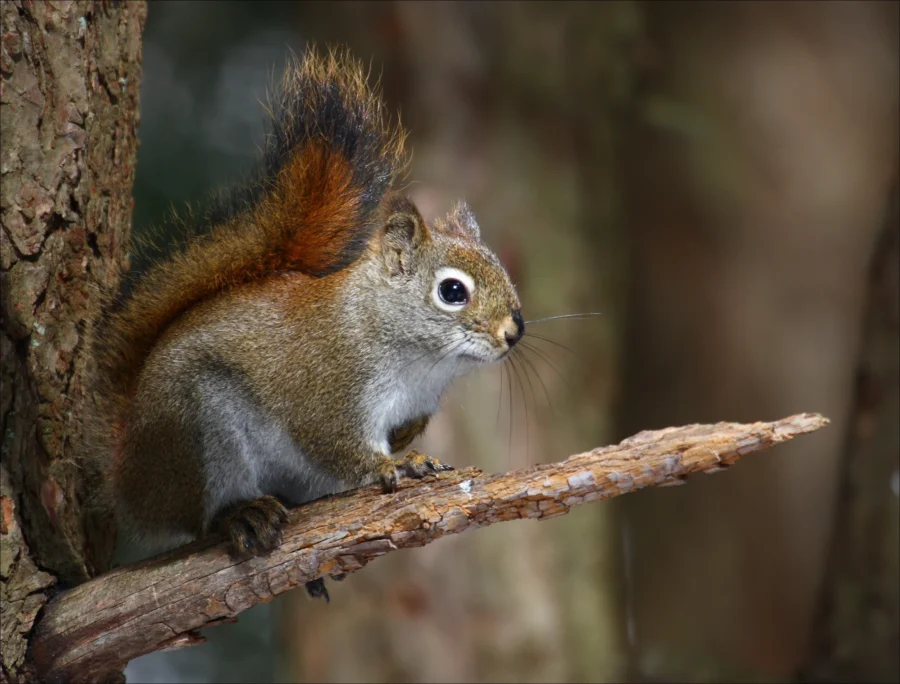
Behavior & Social Structure
Territorial System and Aggressive Defense
American Red Squirrels maintain one of the most rigid territorial systems among North American mammals, displaying aggressive behaviors that far exceed the territorial intensity observed in Eastern Gray Squirrels, Western Gray Squirrels, or Fox Squirrels. Their small size necessitates fierce defense of limited resources.
Territory Establishment and Maintenance:
- Size: Typically 0.2-2.0 acres depending on habitat quality and resource density
- Defense intensity: Absolute exclusion of all conspecifics from core territory
- Boundary marking: Continuous scent marking and vocal advertisements
- Patrol frequency: Multiple daily inspections of territorial boundaries
- Resource protection: Aggressive defense of cone sources and midden sites
Aggressive Behavioral Repertoire:
- Vocal intimidation: Loud, persistent calling to discourage intruders
- Chase sequences: High-speed pursuits driving away territorial violators
- Physical confrontation: Direct attacks including biting and clawing
- Harassment campaigns: Persistent aggressive behavior toward persistent intruders
- Coalition exclusion: Coordinated defense when multiple individuals threaten territory
Territorial Inheritance Systems:
- Generational transfer: Territories passed from mothers to offspring
- Site fidelity: Long-term occupancy of the same territorial areas
- Midden continuity: Inherited food storage sites spanning multiple generations
- Knowledge transfer: Learned information about territory resources and management
- Competitive acquisition: Occasional territorial takeovers through aggressive displacement
Communication Systems and Vocal Behavior
Red Squirrels possess the most extensive vocal repertoire of any North American tree squirrel, with communication systems adapted to their highly territorial lifestyle and dense forest environments.
Vocal Communication Categories:
Territorial and Warning Calls:
- Rattle calls: Rapid-fire warnings for ground-based threats and territorial violations
- Bark sequences: Sharp, penetrating alerts for aerial predators and serious threats
- Chatter calls: Extended vocal displays establishing territorial ownership
- Scream calls: High-intensity vocalizations during physical confrontations
Social and Contact Vocalizations:
- Soft calls: Gentle communication between mothers and offspring
- Contact trills: Location calls maintaining family group awareness
- Courtship calls: Specialized vocalizations during breeding interactions
- Submission sounds: Low-intensity calls indicating non-threatening intent
Contextual Communication:
- Distance calling: Long-range vocalizations spanning forest environments
- Close-range interactions: Detailed vocal exchanges during social encounters
- Emotional states: Vocal variations reflecting stress, excitement, and contentment
- Individual recognition: Unique vocal signatures allowing individual identification
Visual and Chemical Communication:
Tail Signaling:
- Flagging displays: Dramatic tail movements indicating alarm and territorial assertion
- Position communication: Tail postures conveying dominance, submission, and intent
- Grooming signals: Tail manipulation during social bonding activities
Scent Marking Systems:
- Territorial boundaries: Strategic scent placement marking territory edges
- Resource marking: Chemical signals indicating ownership of food sources
- Individual identification: Unique scent signatures facilitating recognition
- Reproductive communication: Pheromone signals during breeding seasons
Daily Activity Patterns and Seasonal Adaptations
Typical Daily Schedule: Red Squirrels maintain highly structured daily routines centered around territory maintenance, foraging activities, and midden management, displaying more rigid scheduling than the flexible patterns typical of larger squirrel species.
Dawn Activity (Sunrise to Mid-Morning):
- Territory inspection: Systematic patrol of territorial boundaries
- Midden maintenance: Organization and protection of food storage sites
- Active foraging: Intensive food gathering during optimal conditions
- Competitor surveillance: Monitoring for territorial intrusions
Midday Behavior (Late Morning to Early Afternoon):
- Rest periods: Energy conservation during peak daylight hours
- Grooming activities: Maintenance of coat condition and parasite removal
- Cache organization: Systematic arrangement of stored food resources
- Nest maintenance: Repair and improvement of shelter sites
Evening Activity (Late Afternoon to Sunset):
- Final foraging: Last intensive feeding before overnight rest
- Territory reinforcement: Vocal and scent marking of boundaries
- Social interactions: Brief encounters with neighboring individuals
- Nest preparation: Preparation of overnight shelter
Seasonal Activity Modifications:
- Winter: Reduced activity with increased reliance on cached resources
- Spring: Extended activity during breeding season and territory establishment
- Summer: Peak activity periods during cone development and early harvest
- Autumn: Maximum activity driven by intensive cone collection and processing
Social Hierarchies and Competitive Dynamics
Despite their intensely territorial nature, Red Squirrels maintain complex social relationships with neighboring individuals that influence resource access and territorial boundaries.
Neighborhood Social Systems:
- Boundary recognition: Stable territorial boundaries between established neighbors
- Familiar neighbor effects: Reduced aggression toward recognized adjacent territory holders
- Information sharing: Indirect communication about predator threats and resource availability
- Competitive restraint: Limited aggression during certain resource abundance periods
- Territorial respect: Mutual recognition of established territorial claims
Dominance Factors:
- Territory quality: Resource richness influencing social status
- Midden size: Food storage capacity affecting competitive ability
- Body condition: Physical health determining aggressive success
- Experience level: Age and familiarity providing competitive advantages
- Seasonal condition: Reproductive status influencing social interactions
Competitive Interaction Management:
- Conflict avoidance: Behavioral strategies minimizing energy-costly confrontations
- Resource sharing: Limited tolerance during extreme resource abundance
- Temporal partitioning: Staggered activity patterns reducing direct competition
- Spatial boundaries: Precise territorial demarcation preventing overlap conflicts
- Stress management: Behavioral adaptations for coping with high-density situations
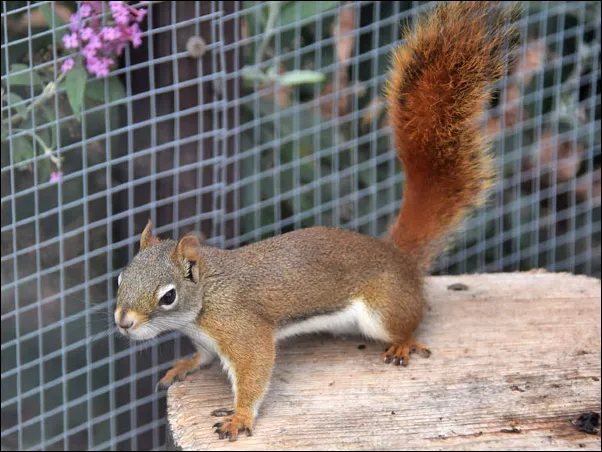
Interaction with Humans and Adaptation to Disturbance
Urban and Suburban Adaptation Strategies
While Red Squirrels show less urban adaptability compared to the highly successful urban populations of Fox Squirrels and Eastern Gray Squirrels, they have nonetheless established populations in suitable urban and suburban environments that provide adequate coniferous habitat.
Urban Habitat Requirements:
- Mature coniferous trees: Parks and neighborhoods with spruce, fir, or pine
- Reduced human disturbance: Areas with limited high-intensity human activity
- Adequate territory size: Sufficient space for maintaining territorial systems
- Cone production: Urban trees capable of producing adequate food resources
- Nesting opportunities: Cavities or suitable sites for drey construction
Urban Behavioral Adaptations:
- Modified territorial size: Smaller territories in high-quality urban habitats
- Altered activity patterns: Adjustment to human activity schedules
- Noise tolerance: Adaptation to urban sound environments
- Food source diversification: Limited utilization of alternative urban food sources
- Predator recognition: Learning to identify urban threats including domestic animals
Urban Population Characteristics:
- Density variations: Higher densities in optimal urban coniferous habitat
- Behavioral boldness: Increased tolerance of human proximity in urban environments
- Resource competition: Intensified territorial defense in limited urban habitat
- Health considerations: Urban stress factors affecting population health
- Genetic isolation: Potential genetic effects of fragmented urban populations
Human-Wildlife Conflict and Management
Red Squirrels create fewer conflicts than larger squirrel species due to their smaller size, but their intense territorial behavior and vocal nature can lead to specific human-wildlife challenges.
Common Urban Conflicts:
- Noise complaints: Loud vocalizations disturbing residents, especially during dawn hours
- Building occupation: Nesting in attics, sheds, and human structures
- Garden damage: Limited digging for cached items and consumption of ornamental plants
- Bird feeder interactions: Competitive exclusion of birds from feeding stations
- Aggressive behavior: Territorial defense creating perceived threats to humans and pets
Conflict Resolution Strategies:
Noise Management:
- Habitat modification: Reducing attractive territorial features near residences
- Tree management: Strategic pruning to redirect territorial boundaries
- Tolerance education: Public awareness about natural behaviors and seasonal patterns
- Timing awareness: Understanding peak vocal activity periods
Structural Exclusion:
- Entry point sealing: Securing openings smaller than 2 inches
- Tree trimming: Reducing access routes to buildings via overhanging branches
- Barrier installation: Physical deterrents preventing building access
- Alternative nesting: Providing suitable nest boxes away from structures
Coexistence Strategies:
- Habitat enhancement: Creating suitable habitat away from conflict areas
- Education programs: Public outreach about Red Squirrel ecology and behavior
- Professional consultation: Wildlife control specialists for complex situations
- Community planning: Urban forestry practices supporting appropriate squirrel habitat
Feeding Guidelines and Human Interaction
Appropriate Feeding Practices: While Red Squirrels can benefit from supplemental feeding, their specialized dietary requirements make appropriate food selection critical for maintaining health.
Recommended Foods:
- Native conifer seeds: Pine nuts, spruce seeds when locally available
- Raw, unsalted nuts: Walnuts, hazelnuts, and almonds in moderation
- Dried fungi: Commercially available mushroom species safe for wildlife
- Fresh tree sap: Maple syrup (pure, without additives) in very small quantities
Foods to Avoid:
- Processed human foods: Bread, crackers, cookies, and candy
- Salted or flavored nuts: Causing dehydration and health complications
- Chocolate products: Containing compounds toxic to small mammals
- Bird seed mixes: Inappropriate nutritional profiles for Red Squirrel requirements
Feeding Best Practices:
- Minimal supplementation: Feeding should supplement, not replace natural foraging
- Seasonal considerations: Increased feeding during harsh winter conditions only
- Location selection: Feeding areas away from roads and predator concentration points
- Cleanliness maintenance: Regular cleaning of feeding areas preventing disease transmission
Educational and Research Opportunities
Red Squirrels provide exceptional opportunities for behavioral observation, ecological education, and citizen science participation due to their distinctive behaviors and vocal nature.
Optimal Observation Conditions:
- Early morning hours (6-9 AM): Peak territorial activity and vocal behavior
- Late afternoon periods (4-7 PM): Active foraging and territorial patrol
- Autumn months (August-October): Intensive cone harvesting and caching behavior
- Winter periods: Midden utilization and winter survival strategies
Behavioral Study Opportunities:
- Territorial behavior: Observation of boundary establishment and defense
- Vocal communication: Documentation of diverse call types and contexts
- Foraging strategies: Study of cone processing and caching techniques
- Social interactions: Analysis of neighbor relationships and competitive dynamics
Educational Value:
- Ecological specialization: Examples of evolutionary adaptation to specific environments
- Territorial systems: Demonstrations of animal space use and resource defense
- Communication complexity: Study of animal vocal behavior and social organization
- Conservation concepts: Understanding of habitat requirements and human impacts
Citizen Science Participation:
- Population monitoring: Contributing to Red Squirrel distribution and abundance surveys
- Behavioral documentation: Recording observations of interesting or unusual behaviors
- Phenology studies: Documenting seasonal activity patterns and timing changes
- Habitat assessment: Evaluating habitat quality and human impact factors
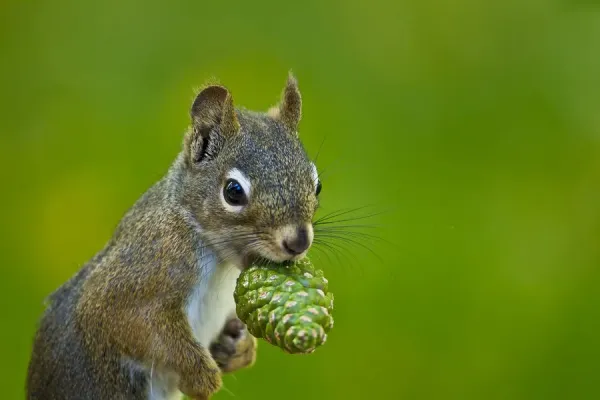
Conservation Status and Management
Population Assessment and Current Trends
American Red Squirrels currently maintain stable populations across most of their extensive range, earning them a “Least Concern” conservation status from wildlife management agencies. However, their populations face unique challenges due to their specialization for coniferous forest ecosystems and sensitivity to habitat fragmentation.
Range-Wide Population Status:
- Overall trend: Stable across core boreal and montane habitats
- Northern populations: Generally healthy with natural population fluctuations
- Southern range edges: Some localized declines due to habitat loss
- Mountain populations: Stable but vulnerable to climate change impacts
- Urban populations: Limited but stable in suitable coniferous habitat
Regional Population Variations:
- Boreal Canada: Strong populations throughout primary habitat
- Rocky Mountains: Healthy populations in suitable elevation zones
- Great Lakes region: Stable populations with some habitat pressure
- Appalachian Mountains: Localized populations facing habitat challenges
- Pacific Northwest: Generally stable with some old-growth dependency concerns
Threats and Conservation Challenges
Climate Change Impacts: Red Squirrels face particularly significant challenges from climate change due to their specialization for northern and montane forest ecosystems.
Climate-Related Concerns:
- Temperature increases: Potential northward shifts in suitable habitat
- Precipitation changes: Altered patterns affecting conifer cone production
- Extreme weather: Increased frequency of storms disrupting food storage
- Growing season shifts: Mismatched timing between reproduction and resource availability
- Tree species composition: Changes in forest composition affecting food resources
Habitat Loss and Fragmentation:
- Logging activities: Removal of mature coniferous forests
- Urban development: Conversion of forest habitat to human uses
- Infrastructure development: Road construction fragmenting populations
- Agricultural expansion: Conversion of forest edges to cropland
- Recreation development: Ski areas and resorts impacting mountain populations
Forest Management Impacts:
- Clear-cutting practices: Removal of mature cone-producing trees
- Fire suppression: Altered natural forest succession patterns
- Selective harvesting: Removal of largest, most productive trees
- Forest fragmentation: Creation of isolated habitat patches
- Plantation forestry: Replacement of diverse forests with monocultures
Interspecific Competition and Predation:
- Eastern Gray Squirrel expansion: Competition in overlapping habitats where forest composition changes
- Invasive species: Competition from non-native animals for resources
- Predator increases: Higher predation pressure in fragmented habitats
- Domestic animal impacts: Predation pressure from cats in suburban areas
- Disease transmission: Potential pathogen introduction from other squirrel species
Conservation Efforts and Management Strategies
Habitat Conservation and Restoration:
- Old-growth protection: Preservation of mature coniferous forest stands
- Corridor development: Creating connections between fragmented habitats
- Sustainable forestry: Management practices maintaining Red Squirrel habitat
- Restoration projects: Replanting of native coniferous species in degraded areas
Research and Monitoring Programs:
- Population surveys: Regular monitoring of density and distribution patterns
- Habitat assessment: Evaluation of habitat quality and carrying capacity
- Climate research: Studies of climate change impacts on populations
- Behavioral studies: Understanding adaptation strategies and requirements
Forest Management Recommendations:
- Retention forestry: Leaving seed trees and snags during harvest operations
- Rotation timing: Harvest schedules maintaining continuous forest cover
- Species diversity: Promoting mixed-age and mixed-species forest stands
- Midden protection: Avoiding disturbance of important food storage sites
Urban Conservation Strategies:
- Urban forestry: Promoting native coniferous species in city planning
- Green space design: Creating suitable habitat in urban environments
- Public education: Awareness programs about Red Squirrel conservation
- Development guidelines: Planning standards protecting important habitats
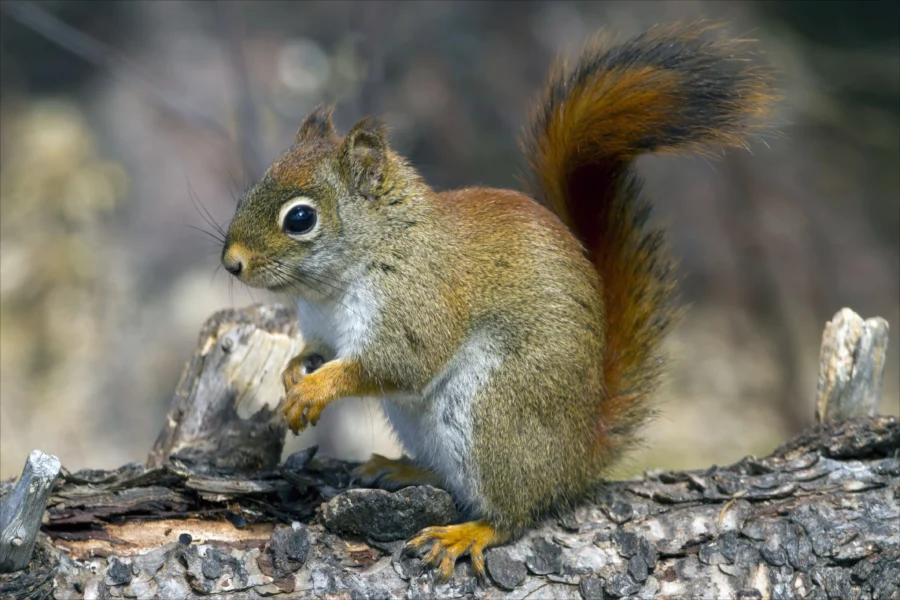
How to Help American Red Squirrels
Creating Red Squirrel-Friendly Habitats
Property owners within Red Squirrel range can take specific actions to support populations while enjoying these remarkable animals’ presence, though habitat requirements differ significantly from those needed by Fox Squirrels or Eastern Gray Squirrels.
Coniferous Tree Selection and Management:
Native Conifer Species:
- White spruce (Picea glauca): Excellent cone production and habitat structure
- Black spruce (Picea mariana): Important for northern and wetland areas
- Balsam fir (Abies balsamea): Valuable for eastern regions
- Douglas fir (Pseudotsuga menziesii): Critical for western mountain areas
- Red pine (Pinus resinosa): Beneficial for Great Lakes region
- Lodgepole pine (Pinus contorta): Important for Rocky Mountain ecosystems
Tree Management Practices:
- Preserve mature trees: Maintain cone-producing age classes
- Diverse age structure: Plant and maintain trees of various ages
- Cavity tree retention: Preserve trees with natural hollows when safe
- Minimal pruning: Avoid excessive trimming that reduces cone production
- Natural regeneration: Allow natural forest succession in appropriate areas
Habitat Structure Development:
- Canopy connectivity: Maintain travel corridors between tree groups
- Understory management: Keep ground cover minimal for easy movement
- Water source provision: Ensure access to clean water within territories
- Edge habitat creation: Develop transitional zones between forest and open areas
- Midden site protection: Preserve existing cone debris accumulation areas
Property Management for Red Squirrel Conservation
Chemical-Free Forest Management:
- Pesticide avoidance: Eliminate chemicals affecting insect food sources
- Organic soil management: Use natural amendments supporting tree health
- Integrated pest management: Biological controls reducing chemical inputs
- Native plant emphasis: Focus on species supporting natural forest ecosystems
Nest Site Enhancement:
- Cavity preservation: Protect trees with existing natural hollows
- Snag retention: Maintain dead trees when safely possible
- Nest box installation: Specialized boxes designed for Red Squirrel requirements
- Artificial cavity creation: Professional tree modification creating nesting opportunities
Seasonal Management Considerations:
- Winter protection: Maintain dense coniferous cover for cold weather shelter
- Spring nesting: Minimize disturbance during breeding and nesting periods
- Summer cone development: Avoid activities disrupting cone formation
- Autumn harvesting: Reduce disturbance during peak caching activities
Conflict Prevention and Humane Solutions
Building Protection Strategies:
Structural Exclusion:
- Entry point sealing: Secure all openings larger than 1.5 inches
- Tree management: Prune branches away from buildings
- Hardware cloth barriers: Install mesh over vulnerable areas
- Chimney protection: Use caps and screens preventing interior access
Garden and Landscape Protection:
- Physical barriers: Protect vulnerable plants with appropriate coverings
- Alternative attractions: Provide preferred habitat away from sensitive areas
- Timing strategies: Plan activities to minimize conflict during peak seasons
- Natural deterrents: Use species that naturally discourage squirrel activity
Humane Exclusion Methods:
- One-way exclusion devices: Allow exit while preventing re-entry
- Professional assessment: Expert evaluation for complex situations
- Timing considerations: Avoid exclusion during dependent young periods
- Follow-up monitoring: Ensure successful exclusion without animal harm
Supporting Red Squirrel Research and Conservation
Citizen Science Opportunities:
- Population monitoring: Participate in annual surveys and distribution mapping
- Behavioral documentation: Record observations of territorial and foraging behaviors
- Midden monitoring: Document changes in food storage site characteristics
- Phenology studies: Track seasonal activity patterns and timing variations
Research Support:
- University partnerships: Support graduate research on Red Squirrel ecology
- Funding contributions: Donate to organizations conducting squirrel research
- Property access: Allow researchers to conduct studies on private lands
- Data collection: Assist with field work and long-term monitoring efforts
Educational Outreach:
- Community education: Share knowledge about Red Squirrel ecology and conservation
- School programs: Support environmental education focusing on forest ecosystems
- Wildlife photography: Document behaviors responsibly for educational purposes
- Conservation advocacy: Promote Red Squirrel habitat protection in community planning
Forest Landowner Recommendations
Sustainable Forestry Practices:
- Partial harvest methods: Maintain continuous forest cover during timber operations
- Seed tree retention: Leave cone-producing trees during harvest activities
- Rotation planning: Schedule harvests maintaining habitat continuity
- Species diversity: Encourage mixed-species forest management
- Midden site avoidance: Protect important food storage areas from disturbance
Habitat Enhancement Projects:
- Conifer planting: Establish cone-producing species in appropriate locations
- Thinning operations: Improve forest health while maintaining squirrel habitat
- Water source development: Create or enhance water availability
- Travel corridor maintenance: Preserve connections between forest patches
- Monitoring programs: Track Red Squirrel usage and habitat effectiveness
Economic Incentive Programs:
- Conservation easements: Financial benefits for protecting important habitats
- Forestry certifications: Programs rewarding wildlife-friendly forest management
- Cost-sharing assistance: Government programs supporting habitat improvement
- Tax incentives: Benefits for maintaining wildlife habitat on private lands
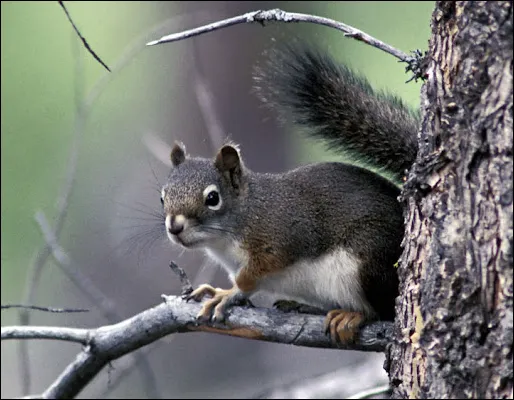
Conclusion
The American Red Squirrel stands as a remarkable example of evolutionary specialization and ecological adaptation, representing the most behaviorally complex and territorially intense member of North America’s tree squirrel community. Unlike the adaptable Fox Squirrel, the forest-generalist Eastern Gray Squirrel, or the oak-specialized Western Gray Squirrel, Red Squirrels have carved out a unique niche as the undisputed masters of northern coniferous forests.
Their success in some of North America’s most challenging environments – from the harsh boreal forests of Canada to the high-elevation mountains of the western United States – demonstrates the power of evolutionary specialization. Through their sophisticated midden systems, intense territorial behaviors, and remarkable vocal communication abilities, Red Squirrels have developed one of the most complex social and ecological systems found among North American mammals.
Understanding Red Squirrel ecology reveals the intricate relationships between species specialization and ecosystem function. Their role as conifer seed dispersers, forest ecosystem engineers through midden creation, and indicators of forest health makes their conservation success crucial for maintaining the integrity of northern forest ecosystems.
The challenges facing Red Squirrel populations – particularly climate change impacts on their specialized habitats and increasing pressure from habitat fragmentation – highlight the vulnerability that can accompany evolutionary specialization. Unlike the more adaptable Eastern Gray Squirrels that thrive in modified environments, Red Squirrels depend on the preservation of intact coniferous forest ecosystems.
Conservation efforts for Red Squirrels benefit entire northern forest communities, as their habitat requirements overlap with countless other species dependent on mature coniferous forests. By protecting and managing forests to support Red Squirrel populations, we simultaneously preserve critical habitats for numerous other wildlife species and maintain the ecological processes that sustain northern forest ecosystems.
Whether marveling at their fierce territorial displays, listening to their complex vocal communications, or observing their industrious cone-harvesting activities, Red Squirrels offer unparalleled opportunities for understanding animal behavior and forest ecology. Their presence indicates healthy, functioning forest ecosystems and serves as a reminder of the remarkable diversity of adaptive strategies that characterize North American wildlife.
The American Red Squirrel’s continued success depends on our commitment to maintaining the mature coniferous forests they require. Through sustainable forest management, climate change mitigation, and habitat conservation efforts, we can ensure that future generations will continue to experience the dynamic energy and ecological importance of these remarkable forest specialists.
In a world where generalist species often dominate human-modified landscapes, Red Squirrels represent the irreplaceable value of specialized species and intact natural ecosystems. Their conservation serves as both a practical necessity for forest ecosystem health and a symbolic commitment to preserving the wild character and biological diversity that define North America’s northern forests.
